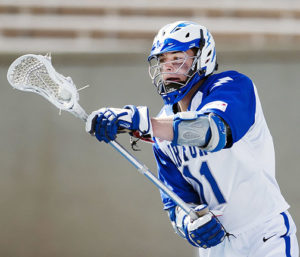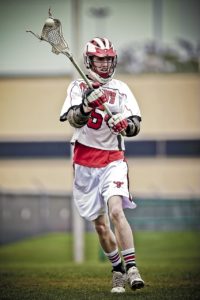Nov 6, 2019Lacrosse: Training players for speed and strength
My colleagues and I are seeing great players of sport but poorly prepared athletes. Today’s college lacrosse players struggle with stress fractures, orthopedic problems, poor posture, tight hip flexors, immobile thoracic spines, poor training histories and soft-tissue injuries. The lack of seasonal play, early specialization in sports, television, internet misinformation, increased cell phone and video game usage, and elimination of physical education in schools have all led to this growing problem.
 To keep these issues from getting worse, we use the offseason to teach athletes to “crawl before they can run.” We emphasize teaching biomechanically clean, coordinated movements rather than the load being lifted.
To keep these issues from getting worse, we use the offseason to teach athletes to “crawl before they can run.” We emphasize teaching biomechanically clean, coordinated movements rather than the load being lifted.
As such, we start by performing primal exercises in our dynamic warmup and show the athletes how to connect movement throughout their bodies. An example would be a bear crawl, which teaches the athletes coordinated movement with their hips and shoulders to build strength, flexibility and motor control.
The players then learn to create, absorb, and redirect force through proper landing and jumping mechanics, Olympic-style weightlifting, squatting, and sprinting mechanics. All of these efforts combine to increase intermuscular and intramuscular coordination and improve synchronization of the central nervous system, leading to more dynamic athletes.
With these areas addressed, we can press on in the offseason toward improved athlete performance. I played collegiate and professional lacrosse, so I have intimate knowledge of the sport and what it takes to prepare both mentally and physically. This gives me an advantage over other lacrosse strength coaches because I can speak to the athletes on a sport-specific level and, most times, directly to the position they play. It also allows me to better explain what we are trying to accomplish in the weight room and how it will translate onto the field.
» RELATED: Maryland men’s lacrosse agility, conditioning drills
Lacrosse players need tremendous strength, power, and flexibility in the kinetic chain. They must be able to maintain an optimum body position in good balance while performing the quick, explosive changes of direction the sport requires. My training philosophy is structured with these factors in mind.
Because lacrosse is a stand-up power sport played in free space, we train our athletes in free space. They work out on their feet using the whole body in a functional and dynamic environment to ensure they utilize every muscle, tendon, and joint in a coordinated and explosive fashion.
We target lifelong wellness during the offseason by taking a holistic approach to developing the healthiest and most complete athletes possible. I utilize and share information from many different fields, such as chiropractic, physical therapy, athletic training, massage therapy, nutrition, biomechanics, functional medicine, weightlifting, and track and field. At UNC, we are fortunate to have access to some of the best clinicians in these fields, and we collaborate with them regularly to ensure our athletes receive cutting-edge treatment.
Injury prevention, improved performance, and overall wellness form the general foundation for our offseason weight room work at the University of Maryland, while the meat of our strength training program employs a variety of strength and power movements. Many of the actions in lacrosse require athletes to move quickly and explosively, so we use several different methods to achieve these athletic properties. Here are some examples.
Ground-based movements
Exercises that are performed with the athlete’s feet on the ground are more productive than exercises performed while sitting or lying down. This is because applying force against the ground causes an equal and opposite reaction in the direction of the movement. The greater the force a lacrosse athlete can generate against the ground, the faster he can run, and the higher he can jump. Furthermore, training with an athlete’s feet on the ground requires him to stabilize his own body structure, which increases proprioception and strengthens stabilization muscles that reduce the risk of injury. The ground-based movements we utilize include squat variations, dead lifts, and lunges.
Multiple-joint movements

Lacrosse athletes benefit from these exercises because they are required to move more than one joint at a time in almost all sporting actions. In addition, research shows that more growth hormone and testosterone are released following multiple-joint exercises, which promotes lean body mass gain. The more lean body mass an athlete can gain, the more force he will produce, and the more effective he’ll be on the field. We work multiple-joint movements with different variations of the power clean, snatches, jerks, and medicine ball throws.
Explosive movements
Using Olympic lifts, medicine balls, and plyometrics for explosive training develops the fast-twitch muscle fibers in the body that enable athletes to create power. This is important in lacrosse because athletes are often called upon to generate a lot of force in a short period of time.
Research shows exercises that require multiple-joint actions timed in the proper neuromuscular recruitment patterns are the most productive in developing explosive power. For example, our athletes execute the “jump and pull” motions of a clean and jerk in 0.2 to 0.3 seconds. Timing this allows the athletes and me to get immediate feedback on whether they have enough movement speed to produce power from the ground up, which develops muscular synergy and proprioception that carries over to sporting actions.
Training explosively also causes a greater exertion to the central nervous system, stimulating the production of endogenous hormones. This develops a greater degree of overall lean muscle mass and strength in our athletes.
Compensatory acceleration
This is a form of speed training to increase explosive power in which athletes apply maximum force against a barbell through a full range of motion. It teaches players to move light weight quickly throughout an entire movement. Because athletes spend more time under maximum tension using this method, they progress much faster in their development.
We use the squat and bench for compensatory acceleration. Occasionally, we add heavy chains or bands to the bar to give variable resistance, and we do multiple sets of low reps with short rest periods to stimulate fast-twitch muscle firing.
Single-leg strength
When competing, lacrosse athletes seldom have both feet in contact with the ground at the same time and must be able to move in either direction with equal efficiency. Therefore, single-leg strength is a key element for success. We work on balancing and exploding off one leg with single-leg squat variations, step-ups with knee drive, single-leg good mornings, and Romanian dead lifts.
Multidimensional movements
The skills utilized in lacrosse involve movement in three planes: side to side, forward and backward, and up and down. Lacrosse players must be functionally strong in all three to be successful. Lifting with free weights is the only way to accomplish this objective. Free weights not only develop primary muscles but also the stabilization muscles that help athletes maintain solid joint integrity and promote better body control.
Core training
The torso is often neglected in lacrosse training, despite being a critical area for success. By developing strong power lines at the torso, we can greatly decrease the risk of injury. In addition, athletes will be able to improve their body control and be more efficient in performing lifts with a strong core, which will allow them to perform better in competition. I like to use medicine ball circuits to train the core.
Posterior chain development
The posterior chain is of vital importance for lacrosse performance, speed development, and injury prevention. Specifically, it plays a critical role in sprinting during lacrosse actions. To focus on posterior chain development, we implement different variations of Olympic-style weightlifting exercises, Romanian dead lifts, hip thrusts, kettlebell swings, glute/ham raises, and reverse hyperextensions.



